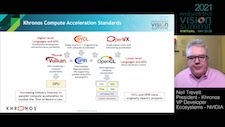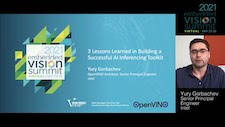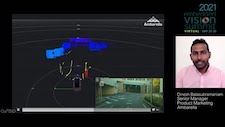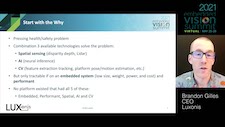| LETTER FROM THE EDITOR |
Dear Colleague,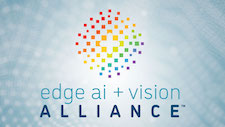
Every year, the Edge AI and Vision Alliance surveys developers to understand what chips and tools they use to build visual AI systems. This is our eighth year conducting the survey, and we would like to get your opinions. Many suppliers of computer vision building-block technologies use the results of our Computer Vision Developer Survey to guide their priorities. We also share the results from the Survey at Edge AI and Vision Alliance events and in white papers and presentations made available throughout the year on the Alliance website. I’d really appreciate it if you’d take a few minutes to complete the first stage of this year’s survey. (It typically takes less than 10 minutes to complete.) We are keeping the survey open through end of day tomorrow, November 11! Don’t miss your chance to have your voice heard. As a thank-you, we will send you a coupon for $50 off the price of a two-day Embedded Vision Summit ticket (to be sent when registration opens). In addition, we will enter your completed survey into a drawing for one of fifty Amazon gift cards worth $25! Thank you in advance for your perspective. Fill out the survey. Next Tuesday, November 16 at 9 am PT, Yole Développement will deliver the free webinar “Neuromorphic Sensing and Computing: Compelling Options for a Host of AI Applications” in partnership with the Edge AI and Vision Alliance. AI is transforming the way we design processors and accompanying sensors, as well as how we develop systems based on them. Deep learning, currently the predominant paradigm, leverages ever-larger neural networks, initially built with vast amounts of training information and subsequently fed with large sets of inference data from image and other sensors. This brute force approach is increasingly limited by cost, size, power consumption and other constraints. Today’s AI accelerators are already highly optimized, with next-generation gains potentially obtained via near or in-memory compute…but what after that? Brain-inspired, asynchronous, energy-efficient neuromorphic sensing and computing aspires to be the long-term solution for a host of AI applications. Yole Développement analysts Pierre Cambou and Adrien Sanchez will begin with an overview of neuromorphic sensing and computing concepts, followed by a review of target applications. Next, they will evaluate the claims made by neuromorphic technology developers and product suppliers, comparing and contrasting them with the capabilities and constraints of mainstream approaches both now and as both technologies evolve in the future. For more information and to register, please see the event page. Brian Dipert |
| DEVELOPMENT TOOLS |
|
Standards: Powering the Future of Embedded Vision Three Lessons Learned in Building a Successful AI Inferencing Toolkit |
| DEPTH SENSING |
|
When 2D Is Not Enough: An Overview of Optical Depth Sensing Technologies DepthAI: Embedded, Performant Spatial AI and Computer Vision |
| UPCOMING INDUSTRY EVENTS |
|
Neuromorphic Sensing and Computing: Compelling Options for a Host of AI Applications – Yole Développement Webinar: November 16, 2021, 9:00 am PT Developing Intelligent AI Everywhere with BrainChip’s Akida – BrainChip Webinar: December 9, 2021, 9:00 am PT Embedded Vision Summit: May 17-19, 2022, Santa Clara, California |
| FEATURED NEWS |
|
An Upcoming Online Event from Unity Technologies Explores Data-centric AI Development Recent Intel Innovation Conference Announcements Include Its 12th Generation Intel Core Microprocessor Architecture and Initial Products, and the oneAPI 2022 Toolkit and Other Developer Offerings Nextchip Licenses aiMotive’s aiWare4 for the Apache6 Automotive Domain Processor Ambarella Intends to Acquire Radar Perception AI Algorithm Developer Oculii Qualcomm Upgrades Its Mobile Roadmap to Deliver Increased Capabilities Across the Snapdragon 7, 6 and 4 Series |
| EDGE AI AND VISION PRODUCT OF THE YEAR WINNER SHOWCASE |
|
Edge Impulse EON Compiler (Best Edge AI Developer Tool) Please see here for more information on Edge Impulse’s EON Compiler. The Edge AI and Vision Product of the Year Awards celebrate the innovation of the industry’s leading companies that are developing and enabling the next generation of edge AI and computer vision products. Winning a Product of the Year award recognizes a company’s leadership in edge AI and computer vision as evaluated by independent industry experts. |


